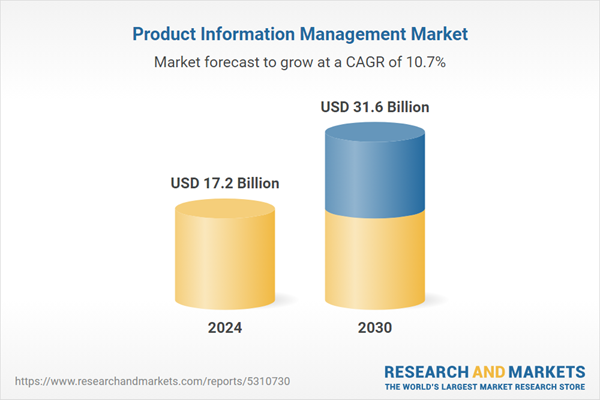Global Product Information Management (PIM) Market - Key Trends & Drivers Summarized
What is Product Information Management, and Why is It Essential for Businesses?
Product Information Management (PIM) refers to the process of centralizing and managing all information related to products, ensuring that accurate, up-to-date product data is available across multiple sales and distribution channels. A PIM system acts as a single source of truth, allowing companies to organize, enrich, and distribute product information seamlessly. PIM solutions are especially critical in industries with extensive product catalogs, such as retail, manufacturing, and e-commerce, where accurate and consistent product data is essential for customer engagement and operational efficiency. By centralizing product data, PIM allows businesses to improve the quality and consistency of product information, minimizing errors and reducing time spent on manual data entry and correction. It also supports faster time-to-market by streamlining product launches and updates, allowing businesses to stay agile in competitive environments.Beyond operational efficiency, PIM enhances customer experience by providing accurate, comprehensive product information, including descriptions, images, specifications, and pricing across platforms. With consumers expecting seamless and detailed product information, particularly in online shopping environments, PIM ensures that product data is consistent, accessible, and informative, supporting customer satisfaction and reducing returns. By integrating PIM with other systems, such as ERP, CRM, and e-commerce platforms, businesses can also automate data synchronization across channels, ensuring consistency in both offline and online customer experiences. This centralized approach helps companies build trust, improve conversion rates, and gain a competitive edge in increasingly data-driven markets.
How Are Technological Advancements Driving the Product Information Management Market?
Advancements in artificial intelligence (AI), machine learning, and automation are significantly enhancing the capabilities of PIM systems, making them smarter, faster, and more adaptable to the complex needs of modern businesses. AI-powered PIM solutions can automate repetitive tasks, such as data cleansing, categorization, and tagging, reducing the time and labor required to maintain accurate product information. Machine learning algorithms enable PIM systems to analyze and improve data quality by detecting inconsistencies, identifying patterns, and suggesting improvements. For example, an AI-enabled PIM can automatically recognize and correct common errors in product descriptions, helping companies maintain high data standards with minimal manual intervention.Cloud-based PIM solutions have also revolutionized the market by offering scalability, flexibility, and easier collaboration among distributed teams. With cloud-based PIM, companies can access product information in real time, collaborate across locations, and quickly adapt to changes in product data requirements. Cloud integration also facilitates seamless data sharing with external systems and partners, such as suppliers and resellers, supporting a more connected and efficient supply chain. Additionally, modern PIM solutions now include advanced analytics tools, allowing companies to gain insights into product performance, consumer behavior, and inventory levels. By leveraging these analytics, businesses can optimize product content, tailor marketing strategies, and improve overall decision-making. Together, these technological advancements make PIM systems more powerful and essential for organizations looking to enhance productivity, agility, and data-driven insights.
Why Are Companies Adopting Product Information Management Solutions?
Companies are increasingly adopting PIM solutions to ensure data consistency, improve customer experiences, and streamline operations. As businesses expand their digital presence across multiple channels, the need for accurate, up-to-date product information becomes critical. PIM systems allow companies to manage all product data from a single source, reducing data silos and ensuring consistency across e-commerce sites, marketplaces, catalogs, and in-store displays. This consistency is particularly valuable in omni-channel retail, where customers expect seamless and uniform experiences across platforms. By consolidating product data, PIM enables companies to deliver consistent, high-quality content that enhances customer satisfaction and supports higher conversion rates.Furthermore, PIM systems help companies meet regulatory compliance and international market requirements. With the expansion of global e-commerce, businesses need to manage varying product data standards, language requirements, and regulatory guidelines across regions. PIM solutions simplify these complexities by allowing companies to localize and customize product data to meet specific market needs, ensuring compliance and reducing the risk of errors. PIM also supports companies in managing product variations, complex hierarchies, and large SKU counts, providing the flexibility to add or modify product attributes quickly. By adopting PIM, companies can improve operational efficiency, reduce time-to-market, and enhance their competitive positioning by delivering accurate, market-ready product data at scale.
What Factors Drive Growth in the Product Information Management Market?
The growth of the product information management market is driven by several key factors, including the rise of e-commerce, the need for data-driven decision-making, and advancements in digital transformation. The proliferation of e-commerce and omni-channel retail has created a strong demand for PIM solutions, as businesses need centralized systems to manage product data across an increasing number of digital platforms. With consumers relying on online product information to make purchase decisions, the importance of accurate, comprehensive data has never been higher. PIM systems offer a reliable solution to meet this demand, supporting companies in delivering consistent information across various online channels, which enhances customer engagement and brand loyalty.Digital transformation across industries has also fueled the adoption of PIM solutions, as companies aim to modernize their data management processes and leverage data for strategic insights. As companies integrate PIM with other enterprise systems, such as ERP, CRM, and inventory management, they can create a more holistic view of product performance, inventory levels, and customer preferences. These integrations support data-driven decision-making, allowing businesses to respond swiftly to market trends, optimize supply chains, and personalize customer experiences. Lastly, the trend toward sustainable and transparent supply chains is encouraging companies to adopt PIM solutions that enable them to accurately track and communicate product attributes, such as sourcing information and environmental impact. Together, these factors highlight the growing significance of PIM in today's data-centric, customer-focused business landscape, positioning it as an essential tool for companies looking to scale, innovate, and remain competitive.
Report Scope
The report analyzes the Product Information Management market, presented in terms of market value (US$ Thousand). The analysis covers the key segments and geographic regions outlined below.- Segments: Component (Solutions, Services); Organization Size (Large Enterprises, SMEs); Vertical (Consumer Goods & Retail, Manufacturing, IT & Telecom, Transportation & Logistics, BFSI, Media & Entertainment, Other Verticals).
- Geographic Regions/Countries:World; United States; Canada; Japan; China; Europe (France; Germany; Italy; United Kingdom; Spain; Russia; and Rest of Europe); Asia-Pacific (Australia; India; South Korea; and Rest of Asia-Pacific); Latin America (Argentina; Brazil; Mexico; and Rest of Latin America); Middle East (Iran; Israel; Saudi Arabia; United Arab Emirates; and Rest of Middle East); and Africa.
Key Insights:
- Market Growth: Understand the significant growth trajectory of the Product Information Management Solutions segment, which is expected to reach US$23.4 Billion by 2030 with a CAGR of a 10.1%. The Product Information Management Services segment is also set to grow at 12.6% CAGR over the analysis period.
- Regional Analysis: Gain insights into the U.S. market, valued at $4.4 Billion in 2024, and China, forecasted to grow at an impressive 14.1% CAGR to reach $7.4 Billion by 2030. Discover growth trends in other key regions, including Japan, Canada, Germany, and the Asia-Pacific.
Why You Should Buy This Report:
- Detailed Market Analysis: Access a thorough analysis of the Global Product Information Management Market, covering all major geographic regions and market segments.
- Competitive Insights: Get an overview of the competitive landscape, including the market presence of major players across different geographies.
- Future Trends and Drivers: Understand the key trends and drivers shaping the future of the Global Product Information Management Market.
- Actionable Insights: Benefit from actionable insights that can help you identify new revenue opportunities and make strategic business decisions.
Key Questions Answered:
- How is the Global Product Information Management Market expected to evolve by 2030?
- What are the main drivers and restraints affecting the market?
- Which market segments will grow the most over the forecast period?
- How will market shares for different regions and segments change by 2030?
- Who are the leading players in the market, and what are their prospects?
Report Features:
- Comprehensive Market Data: Independent analysis of annual sales and market forecasts in US$ Million from 2024 to 2030.
- In-Depth Regional Analysis: Detailed insights into key markets, including the U.S., China, Japan, Canada, Europe, Asia-Pacific, Latin America, Middle East, and Africa.
- Company Profiles: Coverage of players such as Akeneo, Aprimo, Censhare, Contentserv, Enterworks and more.
- Complimentary Updates: Receive free report updates for one year to keep you informed of the latest market developments.
Some of the 59 companies featured in this Product Information Management market report include:
- Akeneo
- Aprimo
- Censhare
- Contentserv
- Enterworks
- IBM
- Informatica
- inRiver
- Magnitude Software
- Mobius
- Oracle
- Perfion
- Pimcore
- Plytix
- Profisee
- Right to Win
- Riversand
- Salsify
- SAP
- Stibo Systems
- Vinculum
This edition integrates the latest global trade and economic shifts into comprehensive market analysis. Key updates include:
- Tariff and Trade Impact: Insights into global tariff negotiations across 180+ countries, with analysis of supply chain turbulence, sourcing disruptions, and geographic realignment. Special focus on 2025 as a pivotal year for trade tensions, including updated perspectives on the Trump-era tariffs.
- Adjusted Forecasts and Analytics: Revised global and regional market forecasts through 2030, incorporating tariff effects, economic uncertainty, and structural changes in globalization. Includes historical analysis from 2015 to 2023.
- Strategic Market Dynamics: Evaluation of revised market prospects, regional outlooks, and key economic indicators such as population and urbanization trends.
- Innovation & Technology Trends: Latest developments in product and process innovation, emerging technologies, and key industry drivers shaping the competitive landscape.
- Competitive Intelligence: Updated global market share estimates for 2025, competitive positioning of major players (Strong/Active/Niche/Trivial), and refined focus on leading global brands and core players.
- Expert Insight & Commentary: Strategic analysis from economists, trade experts, and domain specialists to contextualize market shifts and identify emerging opportunities.
Table of Contents
Companies Mentioned (Partial List)
A selection of companies mentioned in this report includes, but is not limited to:
- Akeneo
- Aprimo
- Censhare
- Contentserv
- Enterworks
- IBM
- Informatica
- inRiver
- Magnitude Software
- Mobius
- Oracle
- Perfion
- Pimcore
- Plytix
- Profisee
- Right to Win
- Riversand
- Salsify
- SAP
- Stibo Systems
- Vinculum
Table Information
| Report Attribute | Details |
|---|---|
| No. of Pages | 398 |
| Published | December 2025 |
| Forecast Period | 2024 - 2030 |
| Estimated Market Value ( USD | $ 17.2 Billion |
| Forecasted Market Value ( USD | $ 31.6 Billion |
| Compound Annual Growth Rate | 10.7% |
| Regions Covered | Global |









